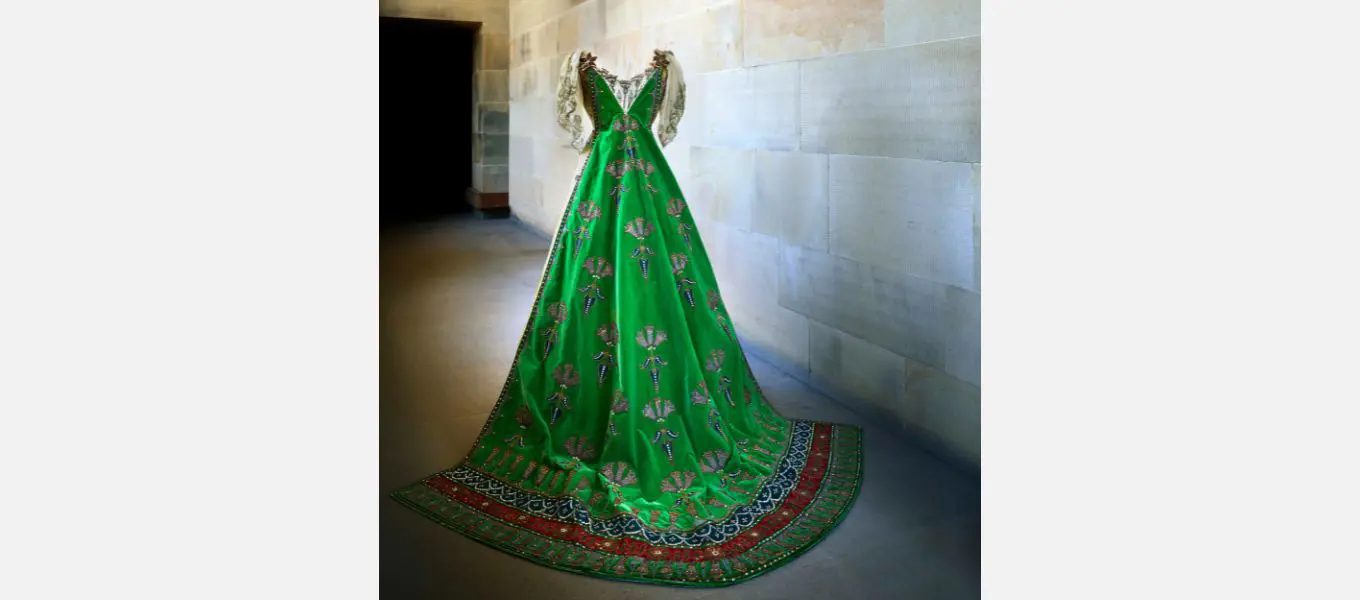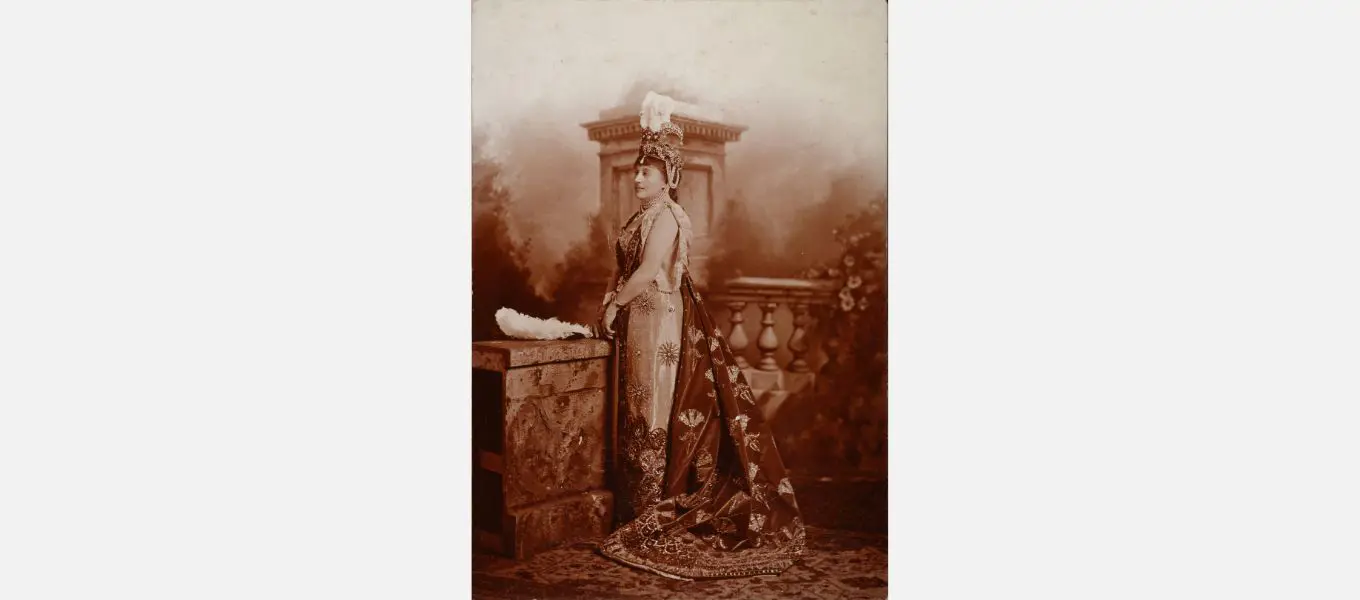‘Colour Revolution’ is at the Ashmolean Museum in Oxford until 18 February 2024. Through 140 objects on loan from collections worldwide, the exhibition dispels the myth that Victorian Britain was a “dreary landscape of ‘dark satanic mills’ and cities choked with smog”, a myth perpetuated through the black and white photography of the period and images of Queen Victoria herself, who spent the last four decades of her life in black mourning clothes after the death of Prince Albert in 1861.
Through thoughtful curation, visitors can follow how developments in science and technology influenced an explosion of colour in art, fashion and design, including the elaborately multi-coloured ball gown designed for Louise, Duchess of Devonshire (1832-1911).

The history of the dress
Every season, the 8th Duke of Devonshire (1833-1908) and Duchess Louise gave a number of high-profile parties and entertainments at their London residence, Devonshire House. The occasion of Queen Victoria’s Diamond Jubilee in 1897 was the perfect opportunity to give the ball of the century.
The Victorians were passionate about fancy dress, and Duchess Louise stipulated on the invitation that dress should be ‘allegorical or historical costume before 1815’.
For her costume, Duchess Louise chose the famous Parisian house of Worth, founded by Charles Frederick Worth in 1858 and then under the creative direction of his son Jean-Phillipe Worth, to produce something both original and beautiful.
Duchess Louise opted to portray Zenobia, the third-century Queen of Palmyra, an idea which may have been inspired by Inigo Jones’s costume designs for court masques preserved by the Chatsworth House Trust in the Devonshire Collections.

Image: Duchess Louise wearing the Zenobia, Queen of Palmyra ball gown and headdress, by Lafayette
The gown comprised a skirt of gold gauze, appliqued with tinsel medallions and peacock plumes worked in bright foils, wire coils and spangled with sequins, which was worn over an ivory satin underskirt wrought over with silver thread and diamonds.
Attached to the shoulders was a long graduated train in vivid emerald green velvet, appliqued with velvet and gold work in an eastern design and studded with jewels.
Images: 1&5. detail of the rear of the gown © Thomas Loof, Images 2-4 detail of fabrics, gems and embroidery © Chatsworth House Trust
The costume was finished with an elaborate headdress of jewels, pearls and feathers. Sadly this has not survived but a replica was made for Chatsworth’s 2017 ‘House Style’ exhibition by Derbyshire-based jewellers, C W Sellors.
Image 1: the replica headdress, Images 2-5, courtesy of CW Sellors
With only a sepia photograph of Duchess Louise wearing the costume as a guide, C W Sellors produced an interpretation of the headdress containing more than 450 gems sourced from all over the world, including Simulated Diamonds, Amethyst, Peridot, Pearls and handcrafted Derbyshire Blue John.
Preparing the delicate dress
The dress was designed for a single night of wear and, as such, was crafted using delicate fabrics and threads upon which were fixed multiple jewels, some of considerable size and weight.
Professional conservation completed around a decade ago has ensured that the fabrics and fabulous colours can be admired for many years to come, however, the original metal clasps holding the jewels in place have started to fail and further conservation is required.
As a result, the dress’s outing at the Ashmolean may be its last until funds can be raised for investigation and repair by the Chatsworth House Trust, the registered charity dedicated to the preservation of the house, collections, garden, woodland and parkland.
Preparing the dress for display at the Ashmolean had to be undertaken with considerable care, with each element mounted onto a mannequin that was then built up with padding to absorb some of the weight and reduce the stress placed on the delicate fabrics and fastenings.
The job of preparing the dress fell to Susie Stokoe and Amy Secker in Chatsworth’s textiles team (pictured above). It took three days to build the dress around the mannequin and pack it for transportation from Chatsworth to Oxford. On arrival at the Ashmolean, Susie completed the dressing of the mannequin in situ, adding the heavy emerald green velvet train.
126 years after its debut, Duchess Louise’s multi-coloured ball gown is once again stealing the show.
The Chatsworth House Trust (registered charity 511149) is dedicated to looking after the house, collections, garden, parkland and woodlands for the benefit of everyone.
All income from ticket sales, Gift Aid, our Chatsworth Friends and Patrons programmes, partners, sponsors and funders goes directly to the charity and is reinvested in the upkeep, preservation and improvement of Chatsworth, our learning programme and essential conservation work, such as the restoration of the Zenobia, Queen of Palmyra ball gown. Find out more about the charity and how you can support its work here.
Colour Revolution: Victorian Art, Fashion & Design is at the Ashmolean Museum in Oxford until 18 February 2024.
Chatsworth House Trust
Chatsworth House Trust is the registered charity dedicated to preserving the house, collections, garden, woodland and parkland for everyone. Find out more about its work.
Louise, Duchess of Devonshire
Duchess Louise was a society beauty, Mistress of the Robes to Queen Victoria, and hostess of the exclusive Devonshire House ball.
House Style
Five centuries of Chatsworth fashion is explored in this coffee table book, beautifully illustrated with archive and new photography.
Devonshire Collections
Discover the art, textiles, sculpture, jewellery and more preserved by the Chatsworth House Trust in the Devonshire Collections.
Image credits:
Main image: detail from the back of the Zenobia ball gown, captured for 'House Style' © Thomas Loof
Image 2: rear view of the Zenobia ball gown, photographed at Chatsworth for 'House Style' © Thomas Loof





